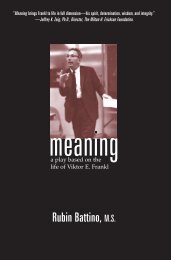Therapy Tough Clients
Look Inside - Crown House Publishing.
Look Inside - Crown House Publishing.
- No tags were found...
Create successful ePaper yourself
Turn your PDF publications into a flip-book with our unique Google optimized e-Paper software.
<strong>Therapy</strong>with<strong>Tough</strong> <strong>Clients</strong>Exploring the Use of Indirectand Unconscious TechniquesGEORGE GAFNER, MSW, LCSW
Praise for <strong>Therapy</strong> with <strong>Tough</strong> <strong>Clients</strong>As Gafner takes the reader through the therapy of two of his mostchallenging clients, he presents what he calls directed unconscioustherapy and often transcends the “translucent membrane” betweenhypnosis and non-hypnotic therapy. This book is intended as a handsonresource and is replete with clinical wisdom. Wonderful-Serious-Wise, this is the work of a true master, <strong>Therapy</strong> with <strong>Tough</strong> <strong>Clients</strong>should be required reading for all entry level therapists and mostseasoned therapists as well.Stephen R. Lankton, MSW,author of Tools of Intention<strong>Therapy</strong> with <strong>Tough</strong> <strong>Clients</strong> was primarily written to be of help to theclinician by offering a variety of approaches to treating challengingcases. But the book does much more than this: Gafner challenges usto recognize and transcend our own limitations, encouraging a personalgrowth that will no doubt spill into performing more creativeand effective psychotherapies. Read this book and you will be better inmore ways than one!Michael D. Yapko, Ph.D., author ofTrancework and Depression is ContagiousWhen searching the bookshelves it is evident that there is virtually noliterature available devoted to exploring the tricky subject of handlingchallenging clients, especially from a hypnotherapy perspective. Notafraid to meet this difficult aspect of the therapeutic relationship headon, George Gafner has written a thought-provoking book that admirablyfills this glaring void. Espousing a refreshing pluralistic approach totherapy he explores working with overt and covert resistance, whilstopenly discussing the often taboo subject of the therapist’s personalcognitive and emotional reactions.One of the many highlights of this engaging book is that approachesare illustrated through on-going case studies, which are constructivelydissected, affording the reader the opportunity to fully get to grips
with every nuance. Ostensibly based around PTSD, there is much tolearn for those not versed in the treatment of trauma as each approachis adaptable to any client that presents a challenge to the therapeuticprocess.Gaffner is an expert in therapeutic story telling and therefore thisbook is unashamedly based around metaphor. That said, other aspectsof hypnotherapy, including the use of paradox, are effectively demonstratedin situ in the abundant therapy transcripts. The author alsoincludes informative discussions on the potentials and pitfalls of usingcultural metaphors, whilst reviewing hypnotic language and hypnoticphenomena for those new to hypnotherapy. With therapists fromevery background in mind, the author discusses how approaches canbe applied both hypnotically and non-hypnotically. He also explorestheir application in a diverse range of settings, from couples therapy tothose working with people held in correctional facilities.This is a well-rounded book that holds something for everyone,irrespective of their therapeutic background.Peter Mabbutt FBSCH, CEO/Director of StudiesLondon College of Clinical HypnosisFans of Milton Erickson and his work with metaphors will love GeorgeGafner’s new book, <strong>Therapy</strong> with <strong>Tough</strong> <strong>Clients</strong>. From the very beginning,it is obvious that the author has mastered the use of metaphorsas he discusses different categories of metaphors: darkness, weight,captor, and descent. In addition, he refers to “overused metaphors”as well as misunderstood cultural metaphors and he also listens to hisclients’ metaphors even before the hypnotic experience begins.The book focuses on two case histories, Maggie and Charles, bothveterans who are suffering from a number of problems since theirreturn from combat. They are introduced in the first chapter, and weget to follow their progress throughout the book, but the book is notlimited to only Maggie and Charles. One interesting case was how hesuccessfully handled a potentially volatile situation when an angryspouse burst into the middle of her husband’s session.Although the book is filled with various metaphors, the authoralso believes in the value of ego strengthening, and devotes an entire
chapter emphasizing it. At the same time, he shows his human sideby sharing a couple of “ooops” comments to let us know that he alsomakes mistakes. Gafner says, “therapy is more of an art than science,”and I totally agree. It is obvious that he is a master of the artistic useof metaphors in therapy, and his book is easy to read.Roy Hunter, FAPHP, DIMDHA,author of The Art of HypnotherapyGeorge Gafner is a seasoned clinician who provides a variety ofcreative ways to use hypnotic procedures and storytelling to treatdiverse clients. He uses case vignettes effectively to illustrate the processof therapeutic decision-making. Anyone who is a follower of theMilton Erickson mode of intervention will find this book engaging andinformative.Donald Meichenbaum, Ph.D., Distinguished Professor Emeritus,University of Waterloo, Ontario, Canada and Research Director ofthe Melissa Institute for Violence Prevention, Miami, Florida
THERAPY WITHTOUGH CLIENTSThe Use of Indirect andUnconscious TechniquesGeorge Gafner, MSW, LCSW
First published byCrown House Publishing LtdCrown Buildings, Bancyfelin, Carmarthen, Wales, SA33 5ND, UKwww.crownhouse.co.ukandCrown House Publishing Company LLC6 Trowbridge Drive, Suite 5, Bethel, CT 06801–2858, USAwww.crownhousepublishing.com© George Gafner, 2013The right of George Gafner to be identified as the author of this work has beenasserted by him in accordance with the Copyright, Designs and Patents Act 1988.First printed 2013All rights reserved. Except as permitted under current legislation, no part of this work may bephotocopied, stored in a retrieval system, published, performed in public, adapted, broadcast,transmitted, recorded or reproduced in any form or by any means, without the prior permissionof the copyright owner. Enquiries should be addressed to Crown House Publishing Limited.British Library Cataloguing-in-Publication DataA catalogue entry for this book is available from the British Library.ISBNISBN: 978–184590–878–2 (print)ISBN: 978–184590–882–9 (mobi)ISBN: 978–184590–883–6 (epub)LCCN: 2013942529Printed and bound in the USA
To Sam Atterbury
ForewordGeorge Gafner is a storyteller and all of his clients know this. It isnot unusual for his clients to ask him to tell them stories during asession. He is also a hypnotist, and has had many years of experienceas a therapist. Storytelling and hypnosis seem to go seamlesslytogether for him (as they do for me). When the story is sufficientlyengaging the listener goes into a kind of reverie state, there is focusedattention, and most therapists would recognize that their client is inwhat can be described as a natural everyday trance. This interactionbetween therapist and client is comfortable and provides a usefulinstantaneous rapport. What better way for a therapist to help a clientwork through difficulties?George has worked with many clients during his professional careerin institutional settings such as the Veterans Administration (V.A.)system and jails. These settings and clients are amongst the most difficultto help with psychotherapy. Many of the veterans have PTSD;prisoners and others in institutional settings may be sociopathic andabuse themselves with drugs and alcohol. Yet, somehow, stories andthe metaphors embedded within them are so universal that theybecome the “royal road” to establish a productive therapeutic alliance.People appear to be more receptive to suggestions when listeningto stories. In that sense the therapist is communicating directlywith the client’s unconscious or inner mind. The more possibilitiesthe therapist builds into the story, the more likely it will be that thelistener will latch onto one or more of the embedded suggestions,and use them to reframe themselves out of their stuckness. Georgeis well aware of this, and especially the need to put into the storytellingsufficient pauses so that the listener can process information inhis/her own unique way. He also understands that in the interpersonalinteraction time in his office that he has to be himself and fromtime to time share some personal things. (The latter, of course, isdone cautiously and with conscious design!)v
ForewordIn this volume, there are many clients whose concerns are discussedin detail. They illustrate George’s experience in working with adiverse population and the ways he chooses to help them. As a kindof leitmotif he focuses on two clients—Maggie and Charles—whoappear repeatedly in the book. Most therapists would regard themas being difficult to work with, and George illustrates this in detail,including his own mistakes. He worries about these sessions andmistakes, and we all learn along with him as he freely lets us participatein his progress with Maggie and Charles. It is almost likelooking over his shoulder as he ponders what to do next—storiesseem to come to the rescue time after time! And he is not afraid tobe directive from time to time.This book is strewn throughout with gems of wisdom and practicalthings to do, and it is well worthwhile studying. As an added bonus,Chapter 14 contains a number of useful story transcripts which canbe adapted to many different circumstances.Rubin Battino, MSYellow Springs, OHvi
ContentsForeword by Rubin BattinovIntroduction 1Chapter 1. Initial sessions with Maggie and Charles 13The Case of Maggie: a referral for individual therapy 13Pandora’s Box 16Notes for practice 19The Case of Charles, another referral for individual therapy 21The Three Lessons 24Notes for practice 25Chapter 2. Metaphor, story and other invaluable devices 29Cultural issues: Missing the point 31Research on metaphor 32Metaphorical examples 33Metaphors for depression 33Hackneyed metaphors and Easy Street 34Concrete metaphors 34The Story and the anecdote 35Hypnotic language 35Hypnotic phenomena and elegant indirect techniques 37Time distortion 38Amnesia 38Dissociation 40Catalepsy 41Taking advantage of hypnotic phenomena in the session 41Integration through discussion? 43Moments of dissociation in a session 44Embedded suggestion 44The Wok 45Waterfalls and enormous soft drinks 45Security anecdote 46Balloons everywhere 46Tony’s Balloons 46Frankie’s Balloons 47Seeding 48Sound seed and split suggestion 49vii
ContentsMisspeak 50Interspersal—another elegant indirect technique 52Indications for use 53Chapter 3. Irritable bowel syndrome (IBS) and continued therapywith Maggie and Charles 55Irritable bowel syndrome 55Healing stories 59White sand beach (Benson, 2011) 59The Molasses Reef story 59IBS-specific anecdotes 61The Burglary 61The Great Vowel Shift 62Notes for practice 62Charles’ second session 63The Garden, a story by Charles 65Notes for practice 67Chapter 4. Ego-strengthening 69Albert Bandura 69Direction versus indirection within hypnosis 70Many tools in the toolbox 71“I need to know I ‘went under’” 71Influence of Erickson 72Ego-strengthening within hypnosis 73Improvement with ego-strengthening alone 75But didn’t Mussolini make the trains run on time? 75Different people, different conclusions 77Ego-strengthening outside of hypnosis 78Group anger management 78Conveying suggestions 79Major ego-strengthening techniques 80Story, anecdote and “short-burst” 80The Greenhouse 80Anecdotes 82245 Feet High 82Lodgepole Pine 82Strong cactus 82Matchstick girl 83Short-burst ego-strengthening 83Mixing techniques in a session? 85Don’t forget Albert Bandura 85viii
ContentsChapter 5. Maggie and Charles continued 87The Case of Maggie 87Recent losses 87Making sense of it all 88Earlier life—and a detour 91A night at PP’s 92Notes for practice 94The case of Charles 95Automatic writing 97Notes for practice 101Chapter 6. Perturbation and pattern interruption 105Stirring the soup 105Perturbation in daily life 105Perturbation with new clients 106Say “uncle” in the ante room, write in the drawing room,or go far in the waiting room 106Generating an evergreen epiphany 107Patterns in daily life 108Pathologic routines 109The case of Kathryn 109The Rationale 110Were the target something else 111Sequencing 112Other ways to perturb 113Pills story 114Instigative anecdotes 116Robert Frost 116Rings in a Dream 116The Shipworm 116Painting Landscapes 117Amplifying the metaphor technique 117Let’s see how Dr. Tracten gets traction with this technique 118Amplifying both metaphors 118Notes for practice 119Fish again 120Recovered memories 120Earl the Pearl 121Chapter 7. Maggie and Charles are back 123Case of Maggie 123Alternating Stories: The Good Spirit and Simple Rooms 126ix
ContentsThe Good Spirit 126Simple Rooms 128(The Good Spirit concluded) 129Notes for practice 129The case of Charles continues 130Charles’ wife bursts into the session 132Pineapple anecdote 134Notes for practice 136Slot Canyon story 136Instigative anecdotes (Gafner, 2004) 139Helen Keller 139Labyrinth 139After the Pond 139Post-It Notes 139Mark Twain 139Chapter 8. PTSD and war 141Persian Gulf War (383 U.S. Dead) 141Barriers to treatment 144PTSD treatment in the V.A. 144World War I (116,000 U.S. Dead) 144World War II (405,000 U.S. Dead), Korea (92,000) andVietnam (58,000) 145Vietnam War 147Help from medication 148Substance abuse 148Psychotherapy and PTSD 148Intrusive images 148EMDR and cognitive-behavioral therapy (CBT) 149Trauma-focused psychotherapy is practiced world-wide 150Watching part of a movie over and over again 150EMDR 151Culture and EMDR 152Current V.A. treatment 153<strong>Therapy</strong> as we know it may not be for everyone 155Finding help in affinity 158The “Performative” 159In conclusion 160Chapter 9. Using story techniques 161Alternating stories with Maggie 161Charles and Bernadette 161x
ContentsActive role of the therapist 162What needs to happen with couples early on 162Patrick’s relationship 163Couple dynamics and marital therapy 164Couples and themes 165Back with Charles and Bernadette 167Cactus story 168Two days later Charles is back 169Road 302 story 171Tyranny of Ten story 174Notes for practice 176Story techniques 177A story for a 64-year old man with heart failure 177Storm Clouds story 178Adding on with a behavior prescription 178Unethical treatment? 179Anecdote within a story 181The Playing Field story 182It can be continuous, mutual, without an ending, orwithin a story 184Mutual storytelling technique 186Story without an ending 186Chapter 10. A curse and the Greek chorus amidst continued therapy 189Maggie returns and her mother reveals the curse 189Notes for practice 193Dora and Antonio 194Fausto and Carmen 195Charles and Bernadette are back 196The Pond 196Charles returns by himself 198Greek Chorus 200Notes for practice 201Chapter 11. <strong>Therapy</strong> nears its conclusion 203Maggie is back 203Charles’ surprise visit 208Notes for practice 212Chapter 12. Farewell to Maggie and Charles 215Maggie’s priest 215Father Sean visits the V.A. a week later 217xi
ContentsFinishing up with Maggie 219Seeing Things Differently 220Maggie’s therapy is concluded 221Bernadette leaves a phone message 222Chapter 13. Employing indirect techniques in various treatmentsettings, and more 223Other indirect techniques 223Confederate outside the door 223Rustling some papers 224An unconventional story application: Strange but true 226Can chickens be incorporated into a treatment plan? 226Back to the basics with a story 227Hypnotic techniques in hospitals, residential treatment,and correctional facilities 228Ramon the screamer 230Young Indian woman 230Milling around 231“I need my meds now!” 231Offal in the shower 232Enter the “tweakers” 23293-year-old pedophile 234“I deserve to die” 235Blind and deaf 235“Maybe I’m interested” 235Tomato story 236Organized crime 236Another view behind bars 236Generating your own material 237Balloons may have been a fantasy 237Refining your therapeutic voice 239What is a good hypnotic voice? 239A good hypnotic voice goes with the client 240Contrasts are your friend 241Your voice in a story and other scripts 241Chapter 14. Favorite inductions and stories 245Story inductions 245Glen Canyon induction 245Rumination Induction (for insomnia) 249The Magic Theater: A guided imagery induction 250xii
ContentsEgo-strengthening stories 253The Maple Tree 253The Little Cactus 255The Lighthouse 257The Balloons 259Instigative stories 260African Violets 260Pauly the Pufferfish 260Silver Fox 262Eating Dirt 263In the Freezer 264Glossary of Terms 267References 285For Further Training and Reading 291Index 295xiii
IntroductionAn enduring teachable momentWhen we do unconsciously-directed work with clients we are privileged,as they open for us that window to the deepest part of them.When we direct therapy through that window—with story, anecdote,hypnotic language, pacing of ongoing response, or variousother techniques—I call this an enduring teachable moment, as it is atime of heightened receptivity. But this is not a one-way glass like weused in the 1970s to view trainees doing therapy. We, as therapists,also have an ongoing process, much of it unconscious, reflected backthrough that window, and in this book I try to capture both sides ofthat window as I take you through therapy with two engaging andmultidimensional people, Maggie and Charles. They represent twoof the most complicated and challenging clients I ever had, and byworking with them I demonstrate a host of techniques that you mayfind useful in doing therapy with your toughest clients.Once I heard someone say that a delight in poetry is “discoveringsomething I didn’t know I knew.” Now, recalling that discovery isan example of this enduring teachable moment, and I’d bet thatwhatever that person read that day in a poem continues to sit theredeep within, waiting to be triggered in the future by a like association.So, too, an enduring teachable moment is evident when I runinto a client I saw 15 years ago and she mentions, “You know, thatold woman in the woods you told me about, I still think about her.”Something triggers the memory of the woman in the story. It may bemention of a cold day, a forest, or of some other aspect of The ThreeLessons story she heard from me years ago, all inextricably linked tothe meta-message of the story, that people have resources within tohelp themselves with their problems. That memorable tale, which Iadapted from a story of the same name by Lee Wallas (1985), is anexample of what you can do in your practice, borrowing from a story1
THERAPY WITH TOUGH CLIENTSor technique in this book, adapting it to your needs, and fashioningit for whatever clinical scenario you encounter.Luis, back from AfghanistanAs the unconscious is certainly the aegis of hypnosis, and as thisbook deals in part with hypnosis, let me share a clinical examplethat opened up this window to me as much as the client. Around2005, I was referred a young Hispanic soldier, Luis, who had recentlyreturned from Afghanistan. His problem was erectile dysfunction.He was in perfect health, on no medications, did not have depressionor PTSD—despite months of harrowing combat—and likemany hypnosis referrals, it came out of frustration after all else hadbeen considered. Luis was married, of average intelligence, spokegood English, and said he didn’t drink or use drugs. He was calm, inno distress whatsoever, and said he wasn’t bothered at all about thewar. His only concern was that he was impotent.The next session we began hypnosis. He responded with deeptrance and amnesia to a conversational induction and The ThreeLessons story, which embeds the suggestion that people haveresources within to help with their problem. The next session Iemployed a similar procedure but added an ego-strengthening storyand set up finger signals for unconscious questioning. Using ageregression, I asked him to go back in time to “any time in the pastthat might have to do with the problem … and when you’re there,Luis, you may let your ‘yes’ finger rise.” After about a minute hisindex finger twitched and he began to mutter some words that wereunintelligible to me, but I did glean a fragment of a phrase, “I-U-D,I-E-D.”I re-alerted him and discussed today’s session. It soon was apparentthat his unconscious mind had mixed up the improvised explosivedevices (IEDs) in the war with his wife’s new intrauterine device(IUD), and impotence resulted. Discussion normalized and integratedthis phenomenon, the problem immediately resolved, he wasseen one more time in a month and was doing fine, end of story.2
IntroductionNow, how many sessions of talk therapy might have been needed toresolve that problem?Peter in jail<strong>Therapy</strong> with Luis was during a scheduled appointment in a comfortableoffice at the Veterans Affairs (V.A.) Medical Center. The conditionswere optimal. But such conditions aren’t always necessary toelicit a similar response within unconsciously-directed therapy. Forexample, I am now retired, for the most part, but I used to workabout four days a month at the local jail. The other day one of thepsychiatrists grabbed me as I was walking by and asked me if I wouldsee this very anxious client I’ll call Peter, a Black male being treatedfor bipolar disorder. I sat with Peter for a few minutes in a busy hallwayoutside the exam rooms in the medical section of the jail. Thefirst thing I noticed was Peter’s very fast and shallow breathing.I showed him deep breathing and asked him if I could tell him a littlestory while he practiced this better way to breathe. “You can closeyour eyes or keep them open, whatever you wish,” I told him Hechose to close his eyes and I told him The Three Lessons story, whichI often use early on. People continued to walk by in handcuffs andchains, doctors and nurses were talking, and it was business as usualwhile Peter responded highly favorably to the story. In two minuteswe were done, his anxiety was allayed, and he left with some tools tohelp him in the future. I have had similar responses in even worseconditions there, like talking to them through the food trap in thedoor in segregation, or standing in the corner of a busy day roomwith the curious walking by, straining to hear what was being said.In other words, a nice office with a recliner and wind chimes music isnice, but if you don’t have it, you can improvise, even in the midst ofrapists and murderers.Standing on broad shouldersIn my years in this business I have learned from many, from my family,colleagues, people in the field, and my trainees, who came from3
THERAPY WITH TOUGH CLIENTSdivergent backgrounds and theoretical perspectives. However, myclients probably taught me more than anyone. For 38 years I workedat clinics and hospitals, and for 28 of those years I directed a programin family therapy and hypnosis training in the V.A. in Tucson,Arizona.I learned from people who had extraordinary experiences, like themen who had been prisoners of war in World Wars I and II, as well asin later wars in Korea and Vietnam. I learned from the reactant andhostile, like the spouses and children who involuntarily attendedfamily therapy, or those who were directed to attend one of the twoanger management groups I conducted for 20 years. One Vietnamveteran with florid PTSD said he was eager to attend because “thisis my 12th marriage and I intend to keep it.” He did well in thegroup and his wife was eternally grateful. Years after the group,when I encountered that man or many others, I asked them whatthey remembered about the group, and invariably they answered,“To take a deep breath or a time-out … but what I liked best wasthe stories you told.” Indeed, stories and anecdotes, both indirect,or unconsciously-directed techniques, have been my allies for manyyears.I learned from my long-term therapy clients and I learned from theones I saw only once or twice, like the paranoid personality disorderwho defied me to try and help him. The V.A. is a fascinating place towork because you encounter a wide diversity of people with everykind of clinical problem. The youngest veteran I saw was 19 and theoldest 102. The oldest couple I saw had been married 76 years. Theirrecipe for a successful marriage? “Always talk things out and nevergo to bed angry.” I learned from the elderly schizoid woman whoseeyes I never saw because of her mirrored sunglasses. I learned fromthe overly compliant and passive, the therapy addicts who lived intheir heads and were resistant to all change however small. I learnedfrom the 200 trainees I had over the years in psychology, psychiatry,nursing, social work and other disciplines. I estimate that over theyears I had to do with some 10,000 clients that I either saw directlyor whose cases I supervised. In this business we quickly learn that4
Introductionsome we help, some we don’t, and some we never know because theyjust fade away.Trying new things as we counter resistanceFor years on Tuesday evenings I was a volunteer therapist at therefugee clinic of the University of Arizona where I saw victims oftorture. These people from Central America, Africa and the Balkanshad experienced all manner of cruelty, loss and humiliation. I’vealways done therapy in either English or Spanish, but sometimes atthis clinic an interpreter was employed, usually a French-speakingmedical student who had done a rotation in Africa. From those inthe refugee clinic I learned how fleeting and precious life is, and howwe need to make the most of those few minutes or hours we are withany client. Seeing people who were able to overcome the most awfulcircumstances somehow made it easier for me to help the majorityof my clients, people whose problems were understandably dear tothem but which paled in comparison to those of survivors of theBataan Death March, or the lone survivor in a village where all werekilled.Along the way I learned patience. With patience you don’t give up onclients and you keep trying new things in order to make an impact.As we try new approaches and techniques we discover what maywork in certain situations, but we especially learn what may workfor us. From these successes we build confidence, and this confidenceis immediately apparent to others. I intended this book to be notonly an aid to your practice, but also an impetus for the growth anddevelopment of the clinician.Scientifically supported treatmentsCurrently, in many quarters there is a strong push to practice onlyone modality for most disorders. Of course, this means some variantof cognitive-behavioral therapy (CBT). I support CBT as a front-lineapproach. However, I know many seasoned psychologists and otherpractitioners—not only those new to the field—who disdainfully5
THERAPY WITH TOUGH CLIENTSthrow up their hands and are at a total loss when the client says, “Ialready had CBT and it didn’t work,” or “I believe my problem residesin my unconscious, and I want therapy directed at that.” I had manyclients who in the first few minutes said, “Please don’t ask me tolist my dysfunctional thoughts; I already did that both in group andindividual therapy.” So what does one do with those clients? Well,please read on.A hands-on resource to assist with the toughest ofclientsI make the assumption that you have been trained in one of themajor disciplines, that maybe you are licensed, and that in yourcounseling or therapy practice you are guided by a generally acceptedtherapeutic approach. You’ve heard the saying, “When you buy a newhammer everything looks like a nail.” Well, I know clinicians whoseaverage day consists of EMDR or hypnosis sessions, hammering onenail after another. I asked them, “What if they have acute grief ora crisis?” You guessed it, EMDR is good for everything, they knowbecause every client looks like a nail. I’m not denigrating EMDR, asI’ve used it for many years, but almost all the time for everyone?For you, perhaps you practice some version of CBT, or a mindfulnessbasedtherapy, or maybe your theoretical orientation is psychodynamic,NLP, or some other popular approach. Perhaps you employmeditation or relaxation and stress management with your clients.If you could use an extra hand with your toughest clients, I encourageyou to read on.When first conceiving this book I thought, “What kind of resourcecan best assist clinicians irrespective of their approach?” As such, Iintended this book to be a hands-on resource that offers you ideas,choices, and opportunities to employ as an add-on to your approach.I’m very familiar with clients who, early on, would set off alarm bellsin my head, you know, where the hair on your neck stands up andyour gut response is, “Oh, no, not another one!” With such clients,you know you have your work cut out for you and maybe you even6
Introductionsay to yourself, “They don’t pay me enough to try and help peoplelike this, let me think … hmm, how can I ensure that they WON’Treturn?” Believe me, I’ve thought those thoughts, but I kept them tomyself, not wanting to be mean-spirited or disrespectful, and wentahead and did my best with people who were, as we say in the U.S., “asharp stick in the eye.” Now, that type of client is an obvious exampleof a person whose resistance and overall presentation are worse thanchallenging. Even with them there are techniques that can help.Building a foundation before advancing to correctivemeasuresWith many people, the challenges are more subtle. You think therapyis progressing well and all of a sudden they start canceling, or justdon’t show up. Something is operating beneath the surface—theissues are too dear, or you failed to put your finger on somethingimportant. In any event, you need to identify and rein in resistanceso that therapy can move forward. For sure, I realize that there aresome clients who simply aren’t ready to address vital issues. Theybolt from therapy early, but hopefully they learned something froma session or two so that this foundation can propel them to successfultherapy in the future.One thing I emphasize in this book is how we can “till the soil beforeplanting the seed” by building a firm base of ego-strengtheningbefore moving on to corrective techniques. I explain this to clientsas “doing a mental building up first,” likening it to a debilitatedmedical patient who requires major surgery (Hammond, 1990). Thatpatient can first benefit from rest and good nutrition, strengtheningher ahead of time. In psychotherapy, I believe that far too oftenthe client comes in and says, “I need help with this problem,” andwe unwittingly jump in with corrective measures. The client isn’tready, we lose them, and once again we’re left ruminating on theold maxim, “Be careful what you ask for.” With a few sessions ofego-strengthening such treatment failures can be avoided. I alwaysemphasized to trainees that early on they concentrate on one thing:7
THERAPY WITH TOUGH CLIENTSEnsuring that the client will return. “If they don’t come back youcan’t help them,” I reminded them.Two other major pitfalls for therapists are 1) low-grade blocks totreatment during the course of long-term therapy, and 2) therapistburnout. You’ve seen this person (or multiple persons, if it’s familytherapy) for a good deal of time, progress is slow but steady, butyou’ve grown weary. And if you feel weary or bored, believe me, it willshow! With both these scenarios there are various techniques thatyou can add to both energize treatment and yourself. Doing therapyis damn hard work and you need to keep adding tools to your toolbox.Even with working part-time now I make sure my toolbox staysheavy. I keep adding tools to it and I haven’t burned out yet.This client is ‘treatment resistant’I always tired of colleagues who surrendered at the least resistance,saying they couldn’t help so-and-so because the client lacked motivation,or was “treatment-resistant.” To be sure, those are accurateterms for some clients, but certainly not all. If people say they wanthelp, they show up and participate as best they can and nothinghappens, they may indeed be resistant, but on an unconscious level.Consciously they’re on the same page as you, but something is holdingthem back. That something usually resides in the unconscious,and that’s where your efforts should be directed. In a workshop oncesomeone asked, “George, does unconscious resistance mean theycan’t help it?” I would argue, in effect, yes, for many, this processlies outside of awareness and thus outside of voluntary control. No,I’m not talking about secondary gain, like the auto accident victimwhose PTSD or neck pain won’t improve until the lawsuit is settled.(If I were the accident victim I wouldn’t improve either!) I’m talkingabout the others who have average or above intelligence, no organiccognitive problems, and no apparent secondary gain. They just can’tget with the program, something is holding them back, and theysimply can’t let go. It’s like any other barrier in therapy that needsto be cleared from your path so you can proceed. However, because8
Introductionwe’re talking about the unconscious here, you need to proceed bygetting in underneath the radar, by hitting the ball beneath the net.The therapist can make something happen in thesessionJay Haley said that it was the job of the therapist to make somethinghappen, and I’ve always taken those words to heart. We have a panoplyof techniques at our disposal to help motivate and to bypass barriersin the unconscious, and many of them I’ll cover in this book.You, kind reader, may already have an ample tool box. My intent inthis book is to augment that tool box many-fold so you can betterinstigate behavior change in your clients, or at least effect a criticalreframe to make life more tolerable. Most approaches to psychotherapyavoid or pay lip service to unconscious process, even thoughconvincing psychological literature indicates that a greater portionof our mental functioning is governed by automatic or unconsciousprocess, by forces that lie outside of voluntary control (Bargh &Chartrand, 1999; Mlodinow, 2012). Milton Erickson demonstratedthe indirect approach beginning in the 1930s when psychodynamictreatment ruled the day, when the unconscious was viewed as aprimordial ooze of negative impulses. Erickson showed us that theunconscious can be a highly employable resource, and in this book Itry to tap into the ways we can access this vault of opportunity, thetherapist’s as well as the client’s.<strong>Therapy</strong> is art informed by scienceI’m a strong supporter of evidence-based treatments but I also believethat in much of real-world mental health treatment we can’t simplyfollow a manual. We must adapt treatment to the unique needs ofthe individual, and the more skills and tools we can bring to bear,the better for both us and our clients. I’ve written extensively onhypnosis—and the application of hypnotic techniques within standardtalk therapy—and this book builds on that work. As such, it is asynthesis of many years of seeing difficult clients, and teaching andwriting about the things we can do to amplify our skills in further9
THERAPY WITH TOUGH CLIENTShelping those clients. In this book I draw on science, but therapyis more art than science. I believe that the science informs the artrather than the other way around.Maggie and CharlesIn this book I take you on an excursion involving the treatment oftwo people, Maggie and Charles. Maggie suffers chronic problems,irritable bowel syndrome and PTSD, and to date she has failed allinterventions. Charles’ problem is acute. A clinical psychologist aswell as a Vietnam veteran, he is distraught, primarily from the guiltof a romantic attachment to one of his own clients; however, astherapy goes on, something deeper and more pervasive is revealed.For both people, problem resolution resides in one place, the unconscious.Through therapy transcripts I demonstrate the range of indirecttechniques that you can bring to bear on the problems of yourclients. The ongoing therapy process is punctuated by chapters thatfurther explicate these techniques. I demonstrate the use of hypnoticlanguage and similar devices through “call-outs,” where italicizedprinciples or techniques in the text are defined in the right margin,thus providing an ongoing explanation of technique and process. Atintervals in the transcript dialogue I critique both the ongoing contentand process. Therefore, the reader is continuously attuned tothe thoughts and reactions of the therapist. People are hard-wiredto appreciate variety, and to this end I attempt to hurl at the reader avast array indirect techniques, all employed to bypass resistance andmove therapy forward.Key components in the bookIt may be intriguing to some that these “hypnotic techniques,” formerlythought to reside exclusively in the sphere of formal hypnosis,can also be employed within standard talk therapy. In this bookI like to think I am intentionally poking a finger into the translucentmembrane separating hypnosis from not-hypnosis. In thedidactic chapters that punctuate the therapy transcripts, I discussconcepts and techniques seldom addressed previously, such as the10
Introductiontherapist’s voice, subtle vocal shift, the pause, the strategic intervalof silence, and seeding, along with the use of these techniquesin non-traditional settings, such as correctional facilities. The use ofstory and anecdote are developed, both for ego-strengthening and toinitiate unconscious problem solving, along with story techniques,such as story without an ending, story within a story, and alternatingstories. I discuss steps for therapists to write their own stories,and where the therapist can locate source material to this end.I try to make the case for integrating ego-strengthening into standardtalk therapy. I advocate it as a “shovel-ready project,” in otherwords, akin to “first picking the low-hanging fruit,” as the therapistbuilds a firm foundation with ego-strengthening before progressingto remediative measures. These clinical accounts are true; however, Ihave sufficiently altered details to protect the privacy of the clients.Nevertheless, the techniques discussed, along with the incidentsdescribed—however strange they may seem—actually occurred.I enjoyed putting this book together. I hope it can serve as a readyto-usereference for you in your practice and help you grow in theprocess. Don’t give up on those difficult clients, as there’s alwayssomething else you can try!11
CHAPTER ONEInitial sessions with Maggie and CharlesThe Case of Maggie: a referral for individual therapyPerusing Maggie’s V.A. medical record before the first session, Iglimpsed a 33-year-old Mexican-American woman who had becomediscouraged and hardened after 12 years of treatment in the U.S.Veterans Affairs system. In the past two years she had had threebrief, voluntary psychiatric hospitalizations for suicidal thought,had been tried on various SSRIs, mood stabilizers and other agents,and had been in and out of individual therapy with a series of psychologyinterns. She continued to decline offers to participate in thePTSD women’s therapy group. Diagnostically, she was classified earlyon with depression and chronic PTSD, and the recent assignment ofborderline personality disorder seemed to reflect staff frustration.Medically, she was followed in a primary care clinic as well as the GIClinic for irritable bowel syndrome.First session with MaggieMaggie had someone with her, a short, rathershriveled up Mexican woman.Maggie: This is my mother. I didn’t have anybodyto watch her. She’s pretty deaf and doesn’t speakmuch English.Therapist: Buenos días, señora.The woman smiled politely, sat down in a chair inthe corner of the office and folded her hands onher lap.13
THERAPY WITH TOUGH CLIENTSMaggie: I have IBS and I hear you tell stories, sothat’s why I’m here. I know you also do hypnosis,but I don’t think I need that.She spoke in a soft but firm voice that had thehuskiness of a smoker. She was tall and lanky andwore a black tank top, shorts and sandals andreeked of marijuana smoke. I could not see hereyes behind mirrored aviator glasses. Her long,black hair framed what was possibly an attractive,olive-skinned face. Actually, little of her facewas visible with the sunglasses and an ArizonaDiamondbacks baseball cap. The profile of herface yielded a pronounced narrow nose seen insome Mexican-Americans in the U.S. Southwest,considered by many as aristocratic or Aztec. Iasked her to remove the sunglasses and when shedid I observed eye contact that was steady, evenintense. Her face remained expressionless as shespoke, except for a slight puffing of her lips thatserved as a perfunctory smile. “This woman is incontrol,” I thought.Therapist: So, you like stories, huh?Maggie: Sometimes. Just so you know, I don’t liketo tell much about myself. I get a copy of my recordevery six weeks. Half of what the doctors write isall wrong.I thought about how some clients routinely requesta copy of their record. This can mean they havefiled a claim for service-connected compensationand are monitoring ongoing documentation onwhich a determination on benefits is based.(In the V.A., clients may be paid for any problemor condition that occurred or was exacerbated bytheir time in the military. From nearly 30 years in thissystem I knew that if a claim was extant, the “greenpoultice” could be at work and the client might not14
Initial sessions with Maggie and Charlesmake much effort to get better. If I were in theirshoes I probably wouldn’t get better either.) I madea mental note to ask about a claim. And then thestory. She mentioned stories right at the beginning,so that’s what I needed to embrace and employright from the start and not be distracted by herproblematic history and provocative presentation.Therapist: So, Maggie, you get any money fromthe V.A.?Maggie: Fifty percent for IBS.Therapist: So, that’s about 500 dollars a month.Maggie: A bit more—and tax-free thankfully. I getby on that plus an odd job now and then. I’m nottaking any classes now. My mom is taking up a lotof my time.Therapist: So, you have IBS. Constipationpredominant?Got a claim in now?Maggie: Constipation big time, Doc! And no, Ihaven’t filed any claims for a long time.Therapist: Please call me George, I’m not a doctor.And when did the gastrointestinal problem begin?Maggie: It started in 1991 when I was in Kuwait inDesert Storm, we were huddled behind a berm withour gas masks on and a SCUD missile zoomedover my head and it literally scared the shit out ofme.Therapist: So, you do talk about yourself sometimes.Maggie: Yeah, when I feel like it.15
THERAPY WITH TOUGH CLIENTSI could see this might be a fairly brief session, whichI didn’t mind, as I appreciate any extra time for thepaperwork. I verified a bit more of her history. Earlyon, I never ask about substance abuse. If they bringit up, fine. If I act interested in that at the start theysometimes don’t return.Therapist: Okay, now is the best part, my story foryou today. You can sit back in that recliner, closeyour eyes or keep them open, whatever feels better… (in a slightly lower volume) as I’ve learnedover the years that a person doesn’t even haveto pay attention because the unconscious mindcan glean anything important, as you slow downyour mind, or your body, become absorbed onthe outside, become attuned to the inside, amuseyourself inwardly, or simply experience relaxationand comfort in your own unique way, as I tell youa little story.Suggestion covering allpossibilitiesThe story is about Pandora and her box, have youheard it before?Maggie: Ancient Greece is all Greek to me.She elevated the recliner’s foot rest and sat back.She crossed her arms on her chest and let thesunglasses fall to the floor. Her mother remainedimpassive but had now closed her eyes.Pandora’s BoxTherapist: This story was first heard around an olivepress …Maggie: Olive oil makes me itch.Therapist: … or maybe at bedtime, who can knowfor sure?Maggie: Bedtime for sure. Pandora is her name,right?16
Whether you’re fairly new to therapy or you’vepracticed for many years, no doubt at times you’vefound yourself stumped with certain clients wholeave you feeling perplexed and discouraged withthat “I-just-don’t-know-what-to-do-next” feeling.This volume by George Gafner revolves around two such fascinating cases, Maggie andCharles. Maggie is a Gulf War veteran and suffers from chronic problems, includingirritable bowel syndrome and PTSD. Charles’s problem is acute. A clinical psychologistas well as a Vietnam veteran he is distraught, primarily from the guilt of a romanticattachment to one of his clients; however, as therapy goes on, something deeper and morepervasive is revealed. For both individuals, problem resolution resides in one place, theunconscious. Following how these cases unfold offers a unique, revealing insight into howa master therapist deals with and confronts his clients from whatever direction best suitsthe client’s psyche. Through the use of transcripts the author demonstrates the panoplyof indirect techniques that a therapist can bring to bear on a client’s problems as he feelsthat all therapists must adapt treatment to the unique needs of the individual, and themore skills and tools that can be brought to bear, the better for both client and therapist.“This book is intended as a hands-on resource and is replete with clinical wisdom. Wonderful-Serious-Wise, this is the work of a true master, and it should be required reading for allentry level therapists and most seasoned therapists as well.”Stephen R. Lankton, MSW, author of Tools of Intention“George Gafner challenges us to recognize and transcend our own limitations, encouraginga personal growth that will no doubt spill into performing more creative and effectivepsychotherapies. Read this book and you will be better in more ways than one!”Michael D. Yapko, Ph.D.,author of Trancework and Depression is Contagious“Gaffner is an expert in therapeutic story telling and this book is unashamedly basedaround metaphor. With therapists from every background in mind, he discusses howapproaches can be applied both hypnotically and non-hypnotically and also explorestheir application in a diverse range of settings, from couples therapy to those workingwith people held in correctional facilities. A well-rounded book that holds something foreveryone, irrespective of their therapeutic background.”Peter Mabbutt, FBSCH, CEO/Director of StudiesLondon College of Clinical HypnosisAbout the Author: George Gafner, MSW, LCSW recently retired from the Southern Arizona VeteransAffairs Medical Center where he was Director of Family <strong>Therapy</strong> and Hypnosis Training. For the past twoyears he has worked part-time as a mental health counselor at a local jail which holds 2,000 inmates. He isthe author of five previous books on clinical hypnosis as well as numerous journal articles.PsychotherapyISBN 978-184590878-2Crown House Publishing Limitedwww.crownhouse.co.ukwww.crownhousepublishing.com9 781 845 908782

















